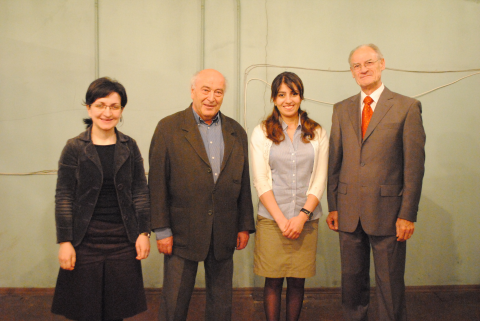
Professor Werner Seibt (honorary fellow of the Dept for Byzantine Research of the Austrian Academy of Sciences, Vienna) is the first scholar who travels to Tbilisi , Georgia as International Adviser in the framework of the "Caucasus and Byzantium from Late Antiquity through the Middle Ages" project.
Professor Seibt spent one week (22-28 May) in Tbilisi meeting colleagues from the Ivane Javakhishvili Tbilisi State University, the Byzantine Department of the Georgian Academy and the National Center for Manuscripts., where he also gave two lectures followed by intensive discussions. The lectures will be published in the future in journals edited by the Georgian Academy of Sciences.
"The Notitia Dignitatum and its Illuminations as Source for the History of the Georgian Black Sea Coast" (Tuesday, May 24)
Abstract: I started to explain the original date of the main part (including the illuminations) and of the additions and corrections, the concept and the problems of the tradition of the text. According to my research the Archetypus was ordered by Stilicho, the Magister peditum of the Western Roman Empire, in 408, some additions (connected with Flavius Constantius, a later Magister peditum) reflect the situation of 413-416, and small last corrections or additions were ordered or done by his widow, the Augusta Galla Placidia. Concerning the civil provincial administration I interpreted the illuminations of the Praefectus Praetoria Illyrici (as there are no illuminations of the Praefectus Praetorio Orientis), of the Vicarius Dioceseos Ponticae, and of the Praeses Thebaidos (as there are no illuminations for the Praeses Ponti Polemoniaci). For the military organisation I choose the illuminations of the Magister Militum per Orientem and of the Dux Armeniae, as he was also responsible for Pontus Polemoniacus. For Pontus Polemoniacus we had to decide which military units were stationed on the Georgian Sea Shore, in modern Abkhazia. To my opinian there were only three strongholds in this region, Pithyus, Valentia (Sebastopolis) and Ziganis. The names of these units point to their establishing in the time of Valens and Theodosius I. To my mind there were no Roman units in Georgia from the late fifties of the 3rd century till the time of Theodosius I. The text of the Notitia was known to some scholars in Georgia, but the color representations of the illuminations from the best preserved manuscript are unpublished and were unknown to the auditorium. Together with the detailed commentary they are very important.
"Byzantine Imperialism Against Georgia in the Later 10th and 11th Centuries" (Wednesday, May 25)
Abstract: After a short introduction (7th through middle of the 10th century) I started with the reign of Davit Kuropalates and his involvements into Byzantine civil wars, what brought him many fortunes but at the end he had to accept the Byzantine emperor as his heir. When he died in 1000 AD emperor Basil occupied his realm (with small exceptions in Tao) and established here the Ducate Iberia, reaching from Tao till Mantzikert in the south. The Byzantine emperor was not pleased with the unification of Western Georgia (called Apchazeti in this time) and the Kartvelian kingdom (parts of Kartli) and tried to weaken the Georgian kingship by close contacts with the opposition, primarily insubordinate feudal lords. In the wars of 1021 and 1022 the Georgian king Giorgi had no chance against the emperor Basil. A seal found in Bulgaria and published by me some years ago is the proof of the establishing of a Byzantine thema in Achazia about 1033, with the centres Anakupia and Pithyus; the Georgian kings could not reconquer this territory till the seventies of the 11th century. The Ducate Iberia was aggrandized by the former kingdom of Greater Armenia (Ani) in 1045 and by the former kingdom of Vanand (Kars) in 1064. Kars was conquered by Georgian troops about 1074 and in former times we thought that this date would have been the end of Byzantine dominion in this region. But I could offer unpublished seals proving that there was a Byzantine commander in Theodosiupolis and Kars in the first years of Alexios' I reign in the early eighties of the 11th century. The relations between the Byzantine emperors and the Georgian kings had become much better after a forced exile of the Georgian king Bagrat in Constantinople (1054 1056), and especially after the marriage of emperor Michael VII with the Georgian princess Martha/Maria "of Alania". Georgian coins especially demonstrate the Byzantine titles of the Georgian kings. In the later 11th and 12th centuries some members of the Georgian feudal nobility went to Constantinople. At the end I showed the unpublished seal of a Niania (Nanes) Liparit (later 12th cenrtury) from my personal seals collection.
Werner Seibt (Dr. phil. 1969, Habilitation 1985) is, since 2006, an honorary fellow of the Departement for Byzantine Research of the Austrian Academy of Sciences. He also held the following positions: Assoc. Professor for Byzantine Studies and Medieval History of Armenia and Georgia at the University of Vienna 1997-2007; the title of Univ. Prof. since 1997; Director of Byzantine and Modern Greek Studies of the University of Vienna 2000-2006; Deputy director of the Byzantine Commission of the Austrian Academy of Sciences 1983-2005. Research interests: Byzantine sigillography, Administration of the Byzantine Empire, Byzantine prosopography, Byzantine Caucasian relations, Byzantine history. Festschrift: "Hypermachos. Studien zu Byzantinistik, Armenologie und Georgistik. Festschrift für Werner Seibt zum 65. Geburtstag" Harrassowitz 2008 (with selected bibliography etc.).